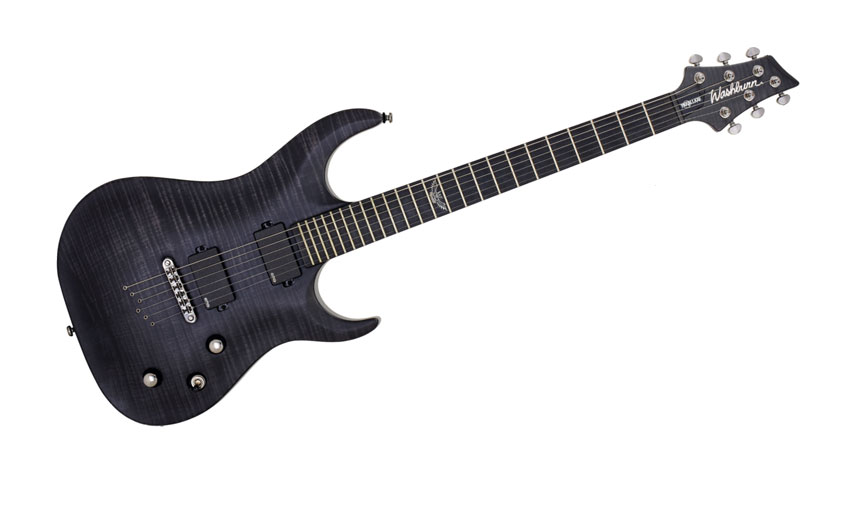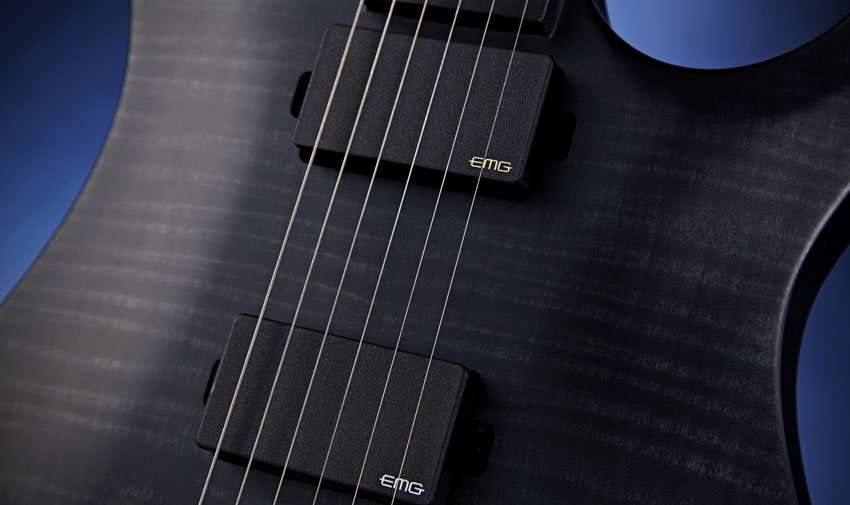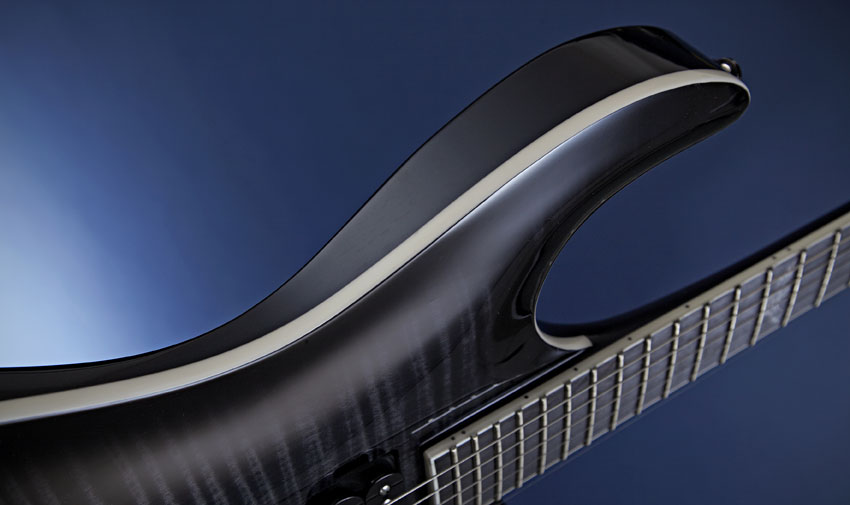MusicRadar Verdict
The through-body stringing and EMG pickups make this ideal for all metal styles: it looks pretty good, too.
Pros
- +
Good build quality and value for money. EMGs do the job. Excellent neck.
Cons
- -
Not the most distinctive tones.
MusicRadar's got your back

Washburn Parallaxe PXM20EFTBM

Finish

Binding

Cutaway
Despite Washburn's long heritage - first establishing itself in the acoustic market in 1883 - the firm's more recent output of electric instruments has often attracted the attention of the rock crowd, being popular with 80s shredders, most famously Nuno Bettencourt, and even being spotted in the hands of Brian May.
2013 sees the company at something of a crossroads as far as electric guitars go, as Washburn's Greg Heritier concedes:
"We've done a wonderful job on the acoustic side, but on the electric side, let's say that there's been somewhat of a lack of products. Nuno's N4 is still there, and we've done some great products with Paul Stanley, but the basic line was fading away." Enter Parallaxe.
Use your head
Heritier was fundamental to the conception of the new series, which comprises a relatively small number of guitars intended to appeal to rock and metal players.
"In the 80s we had a really good share of the market, but when I started working with Metal Battle [a contest that supports upcoming metal artists] I came into contact with many bands and I wanted to get something together, some cool guitars that the advanced player would want to play.
"We wanted to keep elements of the Washburn history," he says of the R&D process. "Things like the Stephen's Extended Cutaway and the pointy headstock, but we also wanted to go a step further, give players something that they could play and not have to modify. We didn't want to make it completely different to everything else, but we wanted to keep the Washburn touch, too."
"Standard features include Buzz Feiten tuning system, baked ebony 'boards and the Stephen's Extended Cutaway heel design"
In a nutshell, the Parallaxe range includes three basic designs that can be distinguished by their headstocks: the double-cut PXS (standard) has a classic six-on-one-side pointed example; the PXM (modern, reviewed here) has an asymmetric three-a-side affair; lastly, the PXL uses the PXM headstock and is named after a contemporary Washburn guitar, the Idol. L is for Idol? Hang on...
"With the PXL we thought a modern version of the Idol would be a cool thing to have," explains Heritier with a smile. "We wanted to change the Idol around a little bit, which is why we chose to take the headstock we'd designed for the PXM."
Configurations include a pairing of Seymour Duncan pickups with a Floyd Rose double-locking whammy, or dual EMGs with through- body stringing, and additional options such as a flame maple veneer, gloss or matt finishes and locking tuners where relevant.
Standard features across the board include the still revolutionary Buzz Feiten tuning system, baked ebony 'boards that bristle with super jumbo-sized frets and both bolt-on and set-neck versions of the Stephen's Extended Cutaway heel design. There's a seven- and eight-string, too, and best news of all, they're all priced below £1,000.
Feel and sounds
We compared the feel of our test Washburn PXM with an LTD MH-1000, and both have necks we love. On one hand, the Parallaxe's massive frets and wide cutaway makes bespoke metal shredding up the dusty end a doddle, aided by the unique heel design, while the LTD's flatter radius, slightly fatter feel and marginally increased mass has its own undeniable appeal.
"The additional abrasive edge afforded by the active electronics gives riffs just the right feel"
Allow us to sit on the fence here: both are perfectly suited to the tasks they're intended for while also offering sufficient subtle differences to allow players to make their own choice as to their favourite, just as it should be.
The dual EMGs ensure that the PXM20, if we're being honest, sounds like pretty much every guitar of a similar ilk, price and spec we've tried over the years. That's not necessarily a bad thing, as for metal tones, the additional abrasive edge afforded by the active electronics gives riffs just the right feel.
The alder body possibly gives the tone more clarity at the high end than mahogany would, and the matt finish, which also includes a flamed maple veneer, really looks the business.
As well as representing a new chapter in Washburn's illustrious history, this guitar also provides yet another choice in what is an already crowed part of the market. Priced competitively this, in turn, will leave the choice of which brand to opt for wholly in the hands of the consumer. Suffice to say, though, this Parallaxe model would suit any modern hard rock player down to the ground.
Simon Bradley is a guitar and especially rock guitar expert who worked for Guitarist magazine and has in the past contributed to world-leading music and guitar titles like MusicRadar (obviously), Guitarist, Guitar World and Louder. What he doesn't know about Brian May's playing and, especially, the Red Special, isn't worth knowing.
“91% believe dynamic pricing should be outlawed”: Music fans have spoken: The Music Fans Voice survey has just released its results
The obscure Andean instrument heard on The Last of Us' soundtrack is the star of Spitfire Audio's latest plugin
"MC5 were playing on the radio": Pere Ubu founder David Thomas has died after “a long illness", aged 71









